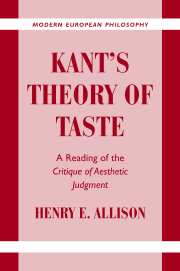Book contents
- Frontmatter
- Contents
- Acknowledgments
- Note on Sources and Key to Abbreviations and Translations
- Introduction
- PART I KANT'S CONCEPTION OF REFLECTIVE JUDGMENT
- 1 Reflective Judgment and the Purposiveness of Nature
- 2 Reflection and Taste in the Introductions
- PART II THE QUID FACTI AND THE QUID JURIS IN THE DOMAIN OF TASTE
- PART III THE MORAL AND SYSTEMATIC SIGNIFICANCE OF TASTE
- PART IV PARERGA TO THE THEORY OF TASTE
- Notes
- Bibliography
- Index
2 - Reflection and Taste in the Introductions
Published online by Cambridge University Press: 18 January 2010
- Frontmatter
- Contents
- Acknowledgments
- Note on Sources and Key to Abbreviations and Translations
- Introduction
- PART I KANT'S CONCEPTION OF REFLECTIVE JUDGMENT
- 1 Reflective Judgment and the Purposiveness of Nature
- 2 Reflection and Taste in the Introductions
- PART II THE QUID FACTI AND THE QUID JURIS IN THE DOMAIN OF TASTE
- PART III THE MORAL AND SYSTEMATIC SIGNIFICANCE OF TASTE
- PART IV PARERGA TO THE THEORY OF TASTE
- Notes
- Bibliography
- Index
Summary
At first glance at least, the account of reflective judgment and its a priori principle, the purposiveness of nature, analyzed in the preceding chapter, does not seem to have much, if anything, to do with taste and aesthetic judgment. Nevertheless, Kant himself clearly intended it to serve as a prelude to his accounts of both aesthetic and teleological judgments, which together constitute the main business of the Critique of Judgment. Accordingly, it is essential to consider the connections that Kant attempts to draw in both Introductions between the faculty of reflective judgment and aesthetic judgment.
The present chapter is therefore devoted to this task and is divided into five parts. The first analyzes the conception of a merely reflective judgment, which Kant introduces in the First Introduction, and the distinction between teleological judgment and aesthetic judgment of reflection as two species thereof. Although anything approaching an adequate analysis of teleological judgment is beyond the scope of this study, we shall nevertheless find that a brief consideration of Kant's treatment of the topic in the First Introduction is useful in understanding how aesthetic judgment might involve reflection. The second and third parts jointly examine the account of aesthetic judgment of reflection given in the First Introduction. The fourth considers the more succinct treatment of this topic in the Second Introduction, where the reference to an aesthetic judgment of reflection is dropped and the focus is instead on the nature and possibility of an aesthetic representation of purposiveness. Although there is no substantive disagreement between these two accounts, the terminological differences point to a significant difference of emphasis, which justifies their separate treatment.
- Type
- Chapter
- Information
- Kant's Theory of TasteA Reading of the Critique of Aesthetic Judgment, pp. 43 - 64Publisher: Cambridge University PressPrint publication year: 2001



